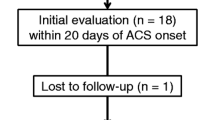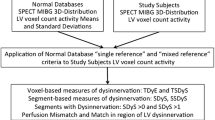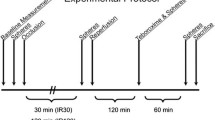Abstract
Introduction
99mTc-sestamibi has been proposed as a viability imaging agent. The purposes of this study were: (1) to determine the relationship between myocardial viability and 99mTc-sestamibi kinetics using perfused rat heart models across a full spectrum of viability, (2) to do so under conditions where myocardial flow was controlled and held constant, and (3) to do so using multiple quantitative methods to assess myocardial viability.
Methods
Twenty-three isolated rat hearts were perfused retrogradely with a modified Krebs-Henseleit (KH) solution. Four groups were studied: controls (C, n = 6), stunned (S, n = 6), ischemic-reperfused (IR, n = 6), and calcium injured (CAL, n = 5). Following a 20-min baseline and subsequent treatment phase, 99mTc-sestamibi was infused over 60 min (uptake) followed by 60 min clearance. Treatment phases consisted of 20 min no flow for S, 60 min no flow followed by 60 min reflow for IR, and 10 min infusion of KH solution without calcium followed by 20 min infusion of KH solution with 2 times normal calcium for CAL hearts. Creatine kinase (CK) assay, triphenyltetrazolium chloride (TTC) staining, and transmission electron microscopic (TEM) analysis were used to determine tissue viability.
Results
Myocardial peak 99mTc-sestamibi uptake (%id) was significantly decreased in IR (4.11 ± 0.22 SEM; p < 0.05) and CAL (1.07 ± 0.13; p < 0.05), but not in S (4.88 ± 0.17) as compared with C (5.99 ± 0.50). One hour fractional retention was 79.3 ± 1.9% for C, 80.3 ± 1.3% for S (p = n.s.), 79.1 ± 1.8% for IR (p = n.s.), and 14.9 ± 4.3% for CAL (p < 0.05 compared to all other groups). 99mTc-sestamibi absolute retention (%id) 1 h after the end of tracer administration was significantly decreased in IR (3.26 ± 0.23) and CAL (0.15 ± 0.02) as compared with both S (3.92 ± 0.16) and C (4.52 ± 0.32) (p < 0.05). CK increased significantly from baseline in the IR and CAL hearts. TTC determined percent viability was 100 ± 0% for C, 98.3 ± 1.1% for S, 82.8 ± 2.6% for IR, and 0.0 ± 0% for CAL. TEM analysis supported these findings. End tracer activity was significantly correlated with TTC determined percentage viable myocardium (r = 0.93, p < 0.05) and CK leak (r = −0.90, p < 0.05).
Conclusion
99mTc-sestamibi myocardial activity is significantly reduced in areas of nonviability after 1 h of tracer uptake and 1 h of tracer clearance. There is a linear correlation between myocardial viability, as determined by three independent methods, and tracer activity.







Similar content being viewed by others
References
Verani MS, Jeroudi M, Mahmarian JJ, Boyce TM, Borges-Neto S, Patel B, et al. Quantification of myocardial infarction during coronary occlusion and myocardial salvage after reperfusion using cardiac imaging with technitium-99m hexakis 2-methoxyisobutyl isonitrile. J Am Coll Cardiol 1988;12:1573–81.
Sinusas AJ, Trautman KA, Bergin JD, Watson DD, Ruiz M, Smith WH, et al. Quantification of area at risk during coronary occlusion and degree of myocardial salvage after reperfusion with technetium-99m methoxyisobutyl isonitrile. Circulation 1990;82:1424–37.
Beanlands RSB, Dawood F, Wen W-H, McLaughlin PR, Butany J, D’Amati G, et al. Are the kinetics of technetium-99m methoxyisobutyl isonitrile affected by cell metabolism and viability? Circulation 1990;82:1802–14.
Okada RD, Glover DK, Nguyen KN, Johnson G III. Technetium-99m sestamibi kinetics in reperfused canine myocardium. Eur J Nucl Med 1995;22:600–7.
Freeman I, Gunwald AM, Hoory S, Bodenheimer MM. Effect of coronary occlusion and myocardial viability on myocardial activity of technetium-99m-sestamibi. J Nucl Med 1991;32:292–8.
Glover D, Okada RD. Myocardial technetium 99m sestamibi kinetics after reperfusion in a canine model. Am Heart J 1993;125:657.
Takehana K, Ruiz M, Petruzella FD, Watson DD, Beller GA, Glover DK. 99mTc-sestamibi defect magnitude predicts the amount of viable myocardium after coronary reperfusion despite the presence of severe residual stenosis. J Nucl Cardiol 2001;8:40–8.
Liu Z, Johnson G III, Beju D, Okada RD. Detection of myocardial viability in ischemic-reperfused rat hearts by Tc-99m sestamibi kinetics. J Nucl Cardiol 2001;8:677–86.
Kaufman GJ, Boyne TS, Watson DD, Smith WH, Beller GA. Comparison of rest thallium-201 imaging and rest technetium-99m sestamibi imaging for assessment of myocardial viability in patients with coronary artery disease and severe left ventricular dysfunction. J Am Coll Cardiol 1996;27:1592–7.
Vom Dahl J, Altechoefer C, Sheehan FH, Buechin P, Schulz G, Schwarz ER, et al. Effect of myocardial viability assessed by technetium-99m-sestamibi SPECT and fluorine-18FDG PET on clinical outcome in coronary artery disease. J Nucl Med 1997;38:742–8.
Chin BB, Esposito G, Kraitchman DL. Myocardial contractile reserve and perfusion defect severity with rest and stress dobutamine (99m)Tc-sestamibi SPECT in canine stunning and subendocardial infarction. J Nucl Med 2002;43:540–50.
Maublant JC, Gachon P, Moins N. Hexakis (2-methoxy isobutylisonitrile) technetium-99m and thallium-201 chloride: uptake and release in cultured myocardial cells. J Nucl Med 1988;29:48–54.
Morguet A, Munz D, Klein H, Pich S, Conrady A, Nebendahl K, et al. Myocardial distribution of indium-111-antimyosin Fab and technetium-99m-sestamibi in experimental nontransmural infarction. J Nucl Med 1992;33:223–8.
Merhi Y, Arsenault A, Latour J. Time course of technetium-99m sestamibi myocardial distribution in dogs with a permanent or transient coronary occlusion. Eur J Nucl Med 1994;21:481–7.
Piwnica-Worms D, Kronauge JF, Delmon L, Holman BL, Marsh JD, Jones AG. Effect of metabolic inhibition on technetium-99m-MIBI kinetics in cultured check myocardial cells. J Nucl Med 1990;31:464–72.
Merhi Y, Latour JG, Arsenault A, Rousseau G. Effect of coronary reperfusion on technetium-99m methoxyisobutylisonitrile uptake by viable and necrotic myocardium in the dog. Eur J Nucl Med 1992;19:503–10.
Weinstein H, Reinhardt CP, Wironen JF, Leppo JA. Myocardial uptake of thallium 201 and technetium 99m-labeled sestamibi after ischemia and reperfusion: comparison by quantitative dual-tracer autoradiography in rabbits. J Nucl Cardiol 1994;1:351–64.
DeCoster PM, Wijns W, Cauwe F, Robert A, Beckers C, Melin JA. Technetium-99m-hexakis-2-methoxyisobutyl isonitrile in experimental myocardial infarction. Circulation 1990;82:2152–62.
Li QS, Soot G, Franceschi D, Wagner HN, Becker LC. Comparison of RP-30 and SQ 32014: myocardial uptake and redistribution in dogs with temporary coronary artery occlusion (abstract). J Nucl Med 1988;29:819.
Dilsizian V, Arrighi JA, Diodati JG, Quyyumi AA, Alavi K, Bacharach SL. Myocardial viability in patients with chronic coronary artery disease: Comparison of 99mTc-sestamibi with thallium reinjection and [18F]-fluorodeoxyglucose. Circulation 1994;89:578–87.
Leon AR, Eisner RL, Martin SE, Schmarkey LS, Aaron AM, Boyers AS, et al. Comparison of single photon emission computed tomography (SPECT) myocardial imaging with thallium-201 and technetium-99m-sestamibi defects. J Am Coll Cardiol 1992;20:1612–25.
Sawata SG, Allman KC, Muzik O, Beanlands RSWB, Wolfe ER Jr, Gross M, et al. Positron emission tomography detects evidence of viability in rest technetium-99m sestamibi defects. J Am Coll Cardiol 1994;23:92–8.
Ford WR, Clanachan AS, Hiley CR, Jugdutt BI. Angiotensin II reduces infarct size and has no effect on post-ischaemic contractile dysfunction in isolated rat hearts. Br J Pharmacol 2001;134 1:38–45.
Carvalho M, Chiu ML, Kronauge JF, Kawamura M, Jones AG, Holman BL, et al. Subcellular distribution and analysis of technetium-99m MIBI in isolated perfused rat hearts. J Nucl Med 1992;33:1516–21.
Chiu ML, Kronauge JF, Piwnica-Worms D. Effect of mitochondrial and plasma membrane potentials on accumulation of hexakis (2-methoxyisobutylisonitrile) technetium(I) in cultured mouse fibroblasts. J Nucl Med 1990;31:1646–53.
Piwnica-Worms D, Chiu ML, Kronauge JF. Divergent kinetics of 201Tl and 99mTc-sestamibi in cultured chick ventricular myocytes during ATP depletion. Circulation 1992;85:1531–41.
Beller GA, Glover DK, Edwards NC, Ruiz M, Simanis JP, Watson DD. 99mTc-sestamibi uptake and retention during myocardial ischemia and reperfusion. Circulation 1993;87:2033–42.
Sinusas AJ, Watson DD, Cannon JM Jr, Beller GA. Effect of ischemia and postischemic dysfunction on myocardial uptake of technetium-99m-labeled methoxyisobutyl isonitrile and thallium-201. J Am Coll Cardiol 1989;14:1785–93.
Acknowledgements
The authors wish to thank the American Heart Association for supporting this project. This study is dedicated to Mr. Henry Zarrow and family, and to William K. Warren and family for their continuing support of medical research, without which these experiments would not have been possible.
Author information
Authors and Affiliations
Corresponding author
Additional information
This work was supported by the American Heart Association, the Anne and Henry Zarrow Foundation, and the William K. Warren Medical Research Foundation.
Rights and permissions
About this article
Cite this article
Liu, Z., Okada, D.R., Johnson, G. et al. 99mTc-sestamibi kinetics predict myocardial viability in a perfused rat heart model. Eur J Nucl Med Mol Imaging 35, 570–578 (2008). https://doi.org/10.1007/s00259-007-0549-4
Received:
Accepted:
Published:
Issue Date:
DOI: https://doi.org/10.1007/s00259-007-0549-4




